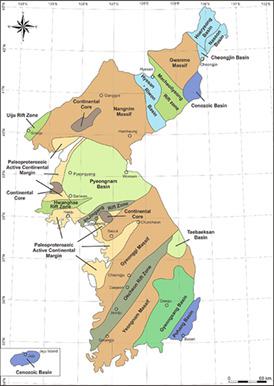朝鲜地质与成矿作用述评(上:前寒武纪)
IF 0.8
4区 地球科学
Q3 GEOLOGY
引用次数: 3
摘要
本文根据朝鲜最近发表的资料,介绍了朝鲜半岛北部的地质和成矿作用。按地质时期顺序描述了地质特征和地质事件,并按地质时期列出了具有代表性的矿床,以说明地质与成矿的关系。特别是根据已报道的锆石U-Pb年龄资料,重新整理了前寒武纪基底地层,重新确定了侵入和成矿的时间。朝鲜前寒武纪大地构造省包括大陆核块、活动大陆边缘和裂谷带。考虑地层重新排列,本文对华北克拉通东部与朝鲜之间的前寒武纪地层进行了新的对比。朝鲜前寒武纪地层的特征是古元古代到中元古代地层的衰竭,与NCC相比为1.8 ~ 1.5 Ga。这一时期朝鲜半岛北部为被动大陆边缘环境。常见的双峰火成岩套(镁质-长英质和碱性-亚碱性)也是朝鲜的特征。从洋壳-大陆俯冲(2.0-2.2 Ga)和岛弧-大陆碰撞(~1.9 Ga)到碰撞后伸展(1.82-1.87 Ga)的渐次构造演化可以很好地解释双峰岩浆作用。中国东北和朝鲜的前寒武纪地质相似性将导致相同或相似的矿化。如中国鞍山—本溪地区铁矿和朝鲜茂山铁矿的阿尔戈马型带状铁组形成于新太古代和古元古代。沉积喷发型铅锌矿床和变质沉积型菱镁矿床形成于中国辽宁裂谷带(青城子矿田的铅锌矿床和大石桥菱镁矿带的菱镁矿床)至朝鲜马舍岭裂谷带(黔德铅锌矿床和大兴-龙阳菱镁矿床)的古元古代沉积喷发型菱镁矿床和变质沉积型菱镁矿床。中国东北地区与朝鲜的大地构造、地质和成矿相似性表明,朝鲜前寒武纪大陆块体可能与北陆块体演化一致。这将有助于认识朝鲜半岛北部的大地构造、地质和相关成矿作用,并与北华北构造带进行对比。本文章由计算机程序翻译,如有差异,请以英文原文为准。

Review on geology and mineralization of North Korea (I: Precambrian)
In this review, we introduce the geology and mineralization of the northern part of the Korean Peninsula based on recently published data in North Korea. Geological characteristics and events are described in order of geological period and the representative mineral deposits are presented according to the geologic period to show the relationship between the geology and mineralization. In particular, we rearrange the stratigraphy of the Precambrian basement and reset the timing of intrusion and mineralization based mainly on the reported zircon U–Pb age data. The Precambrian geotectonic provinces of North Korea contain continental cores and massifs, active continental margins, and rift zones. The Precambrian strata between the eastern North China Craton (NCC) and North Korea are newly correlated considering rearranged stratigraphy in this review. The Precambrian strata of North Korea are characterized by the depletion of the Paleoproterozoic to Mesoproterozoic strata compared to the NCC from 1.8 to 1.5 Ga. It may indicate that the northern part of the Korean Peninsula was the passive continental margin environment during this period. The common occurrences of bimodal igneous suites (mafic‐felsic and alkaline‐subalkaline) are also characteristic of North Korea. The bimodal magmatism is well explained by the progressive tectonic evolution from oceanic crust‐continent subduction (2.0–2.2 Ga) and island arc–continent collision (~1.9 Ga) to post collisional extension (1.82–1.87 Ga) in the NCC including North Korea. The Precambrian geological similarities between Northeastern China and North Korea would have resulted in the same or similar mineralization. For example, Algoma type banded iron formations of the Fe deposits of the Anshan–Benxi area in China and Musan Fe deposit in North Korea were formed during the Neoarchean and Paleoproterozoic. Sedimentary exhalative type Pb–Zn and metasedimentary type magnesite deposits were formed within the Jiao‐Liao‐Ji belt extending from the Liaoning Rift Zone of China (Pb–Zn deposits in the Qingchenzi orefield and magnesite deposits in Dashiqiao magnesite belt) to the Macheollyeong Rift Zone of North Korea (Geomdeok Pb–Zn deposit and Daeheung–Ryongyang magnesite deposits) during Paleoproterozoic. The geotectonic, geological and metallogenic similarities between Northeastern China and North Korea indicate that the Precambrian continental massifs of North Korea might be evolved in accordance with the NCC evolution. This review is expected to be helpful for understanding the geotectonics, geology, and related mineralization of the northern part of Korean Peninsula and correlating with those of the NCC.
求助全文
通过发布文献求助,成功后即可免费获取论文全文。
去求助
来源期刊

Resource Geology
地学-地质学
CiteScore
2.30
自引率
14.30%
发文量
18
审稿时长
12 months
期刊介绍:
Resource Geology is an international journal focusing on economic geology, geochemistry and environmental geology. Its purpose is to contribute to the promotion of earth sciences related to metallic and non-metallic mineral deposits mainly in Asia, Oceania and the Circum-Pacific region, although other parts of the world are also considered.
Launched in 1998 by the Society for Resource Geology, the journal is published quarterly in English, making it more accessible to the international geological community. The journal publishes high quality papers of interest to those engaged in research and exploration of mineral deposits.
 求助内容:
求助内容: 应助结果提醒方式:
应助结果提醒方式:


